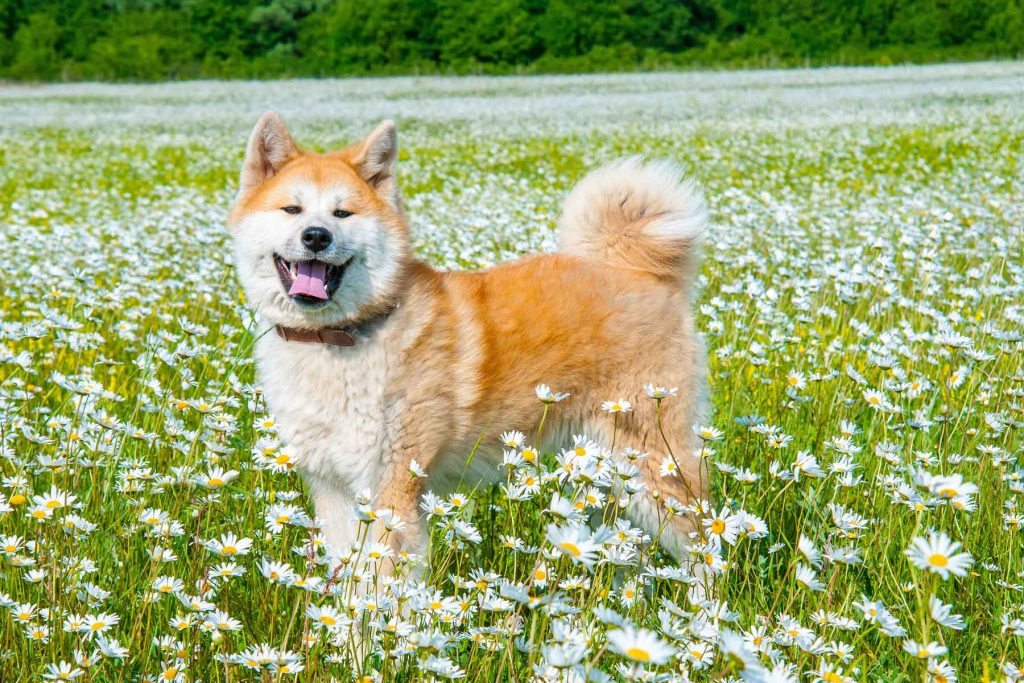
Akitas are the kind of dogs that are loyal, intelligent, and make great family pets. This breed was originally developed in Japan during the 19th century. They are an incredibly versatile breed that can be used for a variety of purposes such as police work, search, and rescue, therapy dogs, acting as service animals for the disabled or blind. Akitas also excel at agility competitions and make great watchdogs because they are always alert and quick to bark at anything out of the ordinary.
If you are considering adding an Akita to your family, or already have one, you might want to know about their shedding. And if that’s the case then this is the article for you.
Akitas are a Japanese breed of dog known for their thick, double coats. Their fur can be any color from black to white, but typically they have a light brown or red coat. Akitas have a thick mane of hair around their neck and chest and long hair on their tails. They are considered ‘all-weather’ dogs because they can tolerate both very hot and cold temperatures well.
There is no denying that Akitas are beautiful dogs. They have a regal air about them and their thick coats of fur make them stand out in a crowd. However, one downside to owning an Akita is that they are heavy shedders.
Akitas shed year-round, but they tend to shed the most during the spring and fall months. So if you're not prepared for it, getting ready for winter with an Akita can be quite a challenge! Their hair will end up all over your clothes, furniture, and even in your food.
Despite their shedding issue, many people still consider Akitas to be great pets. They are loyal companions who love spending time with their family members. And while they may require some extra care when it comes to keeping them clean and free of hairballs, the benefits of owning one definitely outweigh the negatives."
To know about the Akita breed well, it's important to understand the breed's variation between Japanese and American Akitas first.
In general, American Akitas weigh a bit more than Japanese Akitas. American Akitas’ height is also a bit more than the Japanese Akitas. American Akitas are also more refined in appearance and have a thicker coat of fur. The Japanese Akita is considered a "spitfire" - they are independent, strong-willed, and protective of their families. The American Akita is larger in size than the Japanese variety and has a more rugged look. They are known for being loyal companions and good watchdogs. The American Akita can be quite stubborn at times, but with proper training, they make excellent pets.
The American Akita is a larger breed of dog than the Japanese Akita. They both share the same characteristics and temperament, but the American Akita tends to shed more than the Japanese Akita. The reason for this is because of their size difference. The larger dogs have more hair and therefore tend to shed more than smaller dogs.
This can be a bit of a problem if you're not prepared for it, as hair will quickly build up on your floors, furniture, and clothes. If you're okay with dealing with regular shedding then either breed would be a good choice for you, but if you're looking for a dog that doesn't shed as much then the American Akita might not be the best option.
For dogs, shedding is a natural process/stage and most dogs shed at least to some extent throughout their life. Akitas, in particular, are known for their heavy shedding. There are several reasons why Akitas shed so much.
There is no single answer to the question because there are significant variations in how much each dog sheds, and when they reach their peak shedding. Some dogs may only shed once or twice a year, while others may shed constantly. But in general, Akitas shed year-round, and they tend to shed the most during the spring and fall months. Generally speaking, Akitas will reach their peak shedding at around one year old, and will continue to Shed moderately until around four years old. After that point, most dogs will experience a decrease in shedding.
Many people believe that the amount of hair an Akita sheds is related to how much they are groomed; however, this does not seem to be the case as many of the owners of Akita made it clear that they found no relationship between these two. It seems that whether or not an Akita sheds heavily is largely determined by genetics.
The key difference between Akitas and other breeds is that they tend to lose their hair in clumps rather than in small amounts all over their bodies. So if you're not prepared for it, getting ready for winter with an Akita can be quite a challenge! Their hair will end up all over your clothes, furniture, and even in your food.
The Akita is a breed of dog that is often touted as being hypoallergenic. But what does that mean? And are they really hypoallergenic?
Hypoallergenic means that the dog produces less dander and saliva than other breeds of dogs. Dander and Saliva are often the main causes of pet-related allergies. So, if you are allergic to dogs, you may be able to tolerate an Akita better than other breeds.
But it is important to keep in mind that no dog is 100% hypoallergenic. Some people who have allergies may still react to an Akita. If you are considering getting an Akita and you have allergies, it is a good idea to spend some time with one before making your decision. This will help you determine if this breed of dog is right for you
There are many factors that can trigger Akita's shedding. Here are five of the most common:
All of these factors can contribute to increased shedding by Akitas. If you're noticing more hair around your house than usual, it's worth checking into why your dog might be losing more hair. By addressing any underlying issues, you can help reduce the amount of shedding happening in your home.
Shedding is a natural process that all dogs go through, but there are ways to reduce the amount of hair your Akita sheds. Here are some tips:
If you are a dog lover, then you know that one of the joys of owning a dog is getting to enjoy their companionship and also their adorable wagging tails. However, if you are not prepared for the amount of hair your dog will shed, then it might be quite frustrating. Luckily, there are some tips to help keep your home hair free from Akita shedding:
Akitas are known for their thick, double coat of fur. This means that they need to be brushed regularly to remove any dead hair and keep them looking healthy and shiny. The best way to brush an Akita is by using a slicker brush, which can be purchased at most pet stores.
Start by brushing the dog's back, working your way down to the tail. Be sure to get all the way down into the fur around their legs and stomach. Next, use a comb to go through their hair, making sure that there are no knots or tangles. Finally, give them a good bath using shampoo made for dogs
Bathing an Akita can be a daunting task, but with proper instructions, it can be easy and fun. The first step is to gather your supplies: dog shampoo, conditioner (optional), towels, a hose or bucket of water, and a brush or comb.
Next, fill the tub or bucket with warm water and add the desired amount of shampoo. Dunk your dog in headfirst and start lathering up his coat, making sure to get all over including the tail area. Rinse thoroughly before dunking him back in the soapy water for a second bath. If you're using conditioner, apply it now and let it sit for a minute before rinsing off completely.
Finally, use a towel to dry your pup off (or use a hairdryer on low if he's not too shaggy) and give him a good brushing/combing to remove any mats or tangles. Congratulations - you've just bathed your Akita!
There are many reasons why you should not shave your Akita. For instance, Akitas have a thick coat of fur that is meant to protect them from cold weathers. Shaving it off would leave them vulnerable to the elements. Secondly, Akitas are prone to skin infections if their fur is shaved off. Finally, shaving an Akita can actually make their coat grow back thicker and coarser than before. So if you’re thinking about shaving your Akita, think again! There are plenty of other ways to keep them looking clean and well-groomed without sacrificing their natural protection against the cold weather or risking a skin infection.
Though Akita is already a heavy shedder, there might be some times when you might see that your adorable dog is shedding abnormally. If that’s the case then the first step is to take your dog to the veterinarian for a check-up. There are many potential causes of excessive shedding in dogs, from parasites and skin infections to allergies and cancer. Once your veterinarian has ruled out any underlying health problems, you can begin to explore other possible causes of the excessive shedding.
One common cause of abnormal shedding is a lack of essential fatty acids in the diet. Dogs need a certain amount of these fatty acids in order to maintain healthy skin and coats. If your dog's diet does not include enough good quality fats, he may start to shed excessively as his body tries unsuccessfully to compensate for the deficiency. You can improve your dog's diet by adding some high-quality animal fats such as salmon oil or coconut oil into his food bowl every day.
Another possibility is that your Akita may be allergic or sensitive to something in his environment - whether it be pollen, dust mites, pet dander, or something else entirely. Allergies are one of the most common reasons for excessive shedding in dogs, and they can be difficult (and expensive) to treat properly. If you think allergies may be responsible for your dog's Shedding problem, you will need to work with your veterinarian to use appropriate diagnostic tests and treatments to protect him from the allergens he is sensitive to.
In some cases, excessive shedding may also be due to neurological problems such as epilepsy or liver disease. If none of the above reasons seem to be the cause of your Akita’s shedding, it’s time for you to go to the vet again for a detailed examination.
There is no denying that Akitas are heavy shedders, but this doesn't mean they aren't good dogs. In fact, Akitas are known for being loyal and protective companions. They make great family pets and can even be good guard dogs. Despite their heavy shedding, Akitas are worth considering if you're looking for a new dog.

Pet's Better Life is part of Pristine Media, the media division of Pristine Group LLC.
Copyright 2019-2023 Pristine Group LLC. All images and media used in this website are provided by Adobe Stock. Every image is properly licensed for use on this website.